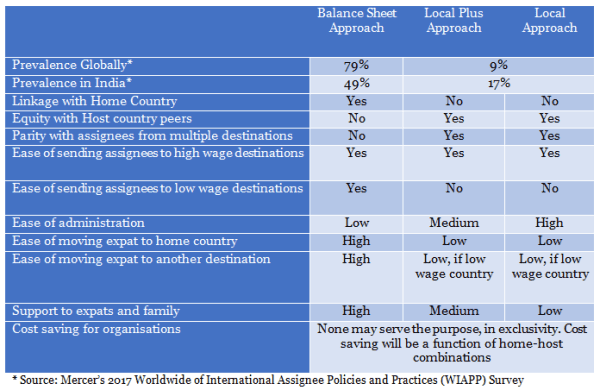Decrypting expatriate compensation: The three common approaches – Balance Sheet, Local+ and Local

There is no denying that global mobility is growing in importance and organizations have started valuing the importance of global mobility, as part of their talent management strategy. According to Mercer’s 2017 Worldwide of International Assignee Policies and Practices (WIAPP) Survey, 64% companies in India plan to increase their long-term assignments. Deploying talent globally and retaining this key talent, will be an important cornerstone of a successful talent strategy. An important part of attracting and retaining this global talent is international assignee or expatriate compensation.
International assignee compensation is viewed cryptically often, as it uses a lot of benchmarks or research data, as a base for arriving at the final compensation package. Since assignee may be accompanied by family and will be on single income, for a considerable duration, there is immense interest on the part of the assignee to understand the foundation of his/her compensation design. Though compensation approach is only one part of the assignment policy, since a lot of elements go into pre-assignment as well as post assignment, however, it is one element, which is viewed with utmost interest and demands a lot of understanding.
KEY DEFINITIONS:
So, before we talk about approaches to international assignee compensation, let's understand some key definitions:
- Long-Term Assignment: An international assignment that usually lasts one to five years, after which the employee is either expected to go on another assignment or return to the home country.
- Home Country: The employee’s actual home country or base country.
- Host Country: The country to which an expatriate is assigned to work, always different from the home country. Also, known as assignment location.
- Spendable Income: As the name suggests, it is the disposable income. It is the portion of salary, needed in the home country for household expenditure on goods and services, post taxes, savings, and house. It is an important reference since home spendable income is adjusted by a cost of living index to produce a host spendable. This ensures that an assignee’s buying power is maintained in their host country while preserving housing and savings obligations in their home country.
- Reserve: It is also commonly known as ‘savings’. The elements of income other than goods and services, housing, taxes or social security. It typically includes savings and investment portfolios.
COMPENSATION APPROACHES:
There are typically three common compensation approaches for International Assignees, globally. These approaches fall on the left or right side of the home-host continuum, namely:

Globally, 12% and 34% of companies in India, follow alternative approaches to compensation, for international assignees. We will discuss these in the next article.
Deciding the best approach
While there are multiple compensation approaches and hybrid approaches of the above combinations, organizations need to decide on the objective of the assignment and metrics to drive the effectiveness of the assignment. Cost cutting should be the only reason for moving from one compensation approach to the other. Different compensation approaches can be used depending on the nature of the assignment, strategic vs. tactical, duration of the assignment, long term or short term. So, is it possible to segment the policies appropriately to drive down cost?
While looking at a comparison of local plus and balance sheet, it is important to tackle the ‘benefits’ or the ‘plus’ bucket and review its impact on the overall package closely. It may be fruitful to establish the levels of housing, education and home leave benefits to provide, tiered by organization level. While administratively local plus and local packages look lucrative, however, organizations need to monitor equivalence. It may be an excellent approach to run a comparison for all three methods for select countries of your destination, to arrive at the cost-effective conclusion.
It is essential to remember that what works for one organization may not work for the other. The life stage of internationalization, organizational objectives, corporate employer brand and budgets, all may differ. Hence, what works for one organization, may not work for the other. Therefore, merely aping ‘popular’ approaches or aping ‘best practices’ may not be the best solution.
In the end, no matter what the compensation approach, the organization should not miss the fact that the assignee has uprooted themselves and their family, he/she has taken the risk and the challenge of being in a new country for an organizational need and requirement. Hence, there is a need for supporting the assignee and catering to their extra needs of housing, education, security, medical, spousal support, etc.
Watch this space to know in depth about the three approaches











